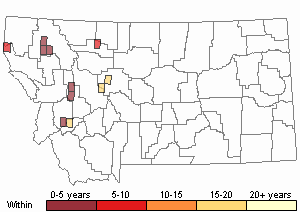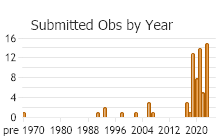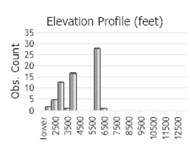View in other NatureServe Network Field Guides
NatureServe
Montana
Utah
Wyoming
Idaho
Wisconsin
British Columbia
South Carolina
Yukon
California
New York
Mud Bithynia - Bithynia tentaculata
Other Names:
Faucet Snail
State Rank Reason (see State Rank above)
Unrankable in Montana as an introduced/exotic species.
General Description
This introduced operculate snail species has been reported in Montana within the last 50 years. Also known as faucet snails, which is a misnomer as they prefer lakes and ponds instead of moving water (rivers and streams).
Range Comments
Members of this family are found native throughout Europe, Asia, and in Africa, Indonesia, the Philippines and Australia. This species was introduced a long time ago to North America and has spread widely. However, it has been reported in Pleistocene deposits in Chicago so it may already have been in North America at the time of European settlement (Burch 1989). It has recently (last 50 years) been reported in Montana from the Flathead Basin and Georgetown Lake.
For maps and other distributional information on non-native species see:
Nonindigenous Aquatic Species Database from the U.S. Geological Survey
Invasive Species Habitat Tool (INHABIT) from the U.S. Geological Survey
Invasive Species Compendium from the Centre for Agriculture and Bioscience International (CABI)
EDDMapS Species Information EDDMapS Species Information
Observations in Montana Natural Heritage Program Database
Number of Observations: 82
(Click on the following maps and charts to see full sized version)
Map Help and Descriptions
Relative Density

Recency



 (Observations spanning multiple months or years are excluded from time charts)
(Observations spanning multiple months or years are excluded from time charts)
Migration
Sedentary, this species only long-distance movement is being transported by humans or other animals
Habitat
In the shallow lakes and ponds where it resides this snail can be found on the underside of rocks and other substrates, as well as on aquatic macrophytes (milfoil (Myriophyllum spicatum and muskgrass, Chara spp.) in the warmer months (Vincent et al. 1981, Pennak 1989, and Jokinen 1992). And, found at the bottom of spring-water beds during winter, where water temperature does not go below 4°C during an average winter. B. tentaculata will not be found in fast running water, since the high velocity will make it impossible for the snail to adhere to suitable substrates or macrophytes.
Food Habits
This species functions as both a scraper and a collector-filterer, grazing on algae on the substrate, as well as using its gills to filter suspended algae from the water column. When filter feeding, algae is sucked in, condensed, and then passed out between the right tentacle and exhalant siphon in pellet-like packages which are then eaten (Jokinen 1992).
Ecology
The Mud Bithynia can be a food item for the common carp (Cyprinus carpio) (Ricciardi 2001), waterfowl, as well as predatory crayfish and leeches.
Management
It would be wise not to cause the unwanted spread of this snail. The faucet snail is the vector passing trematode infection to waterbirds that eat this snail causing death to the bird. B.
tentaculata is the first and second intermediate host in the trematode life cycle (Sauer et al. 2007).
Contact information for Aquatic Invasive Species personnel:Montana Fish, Wildlife, and Parks Aquatic Invasive Species staffMontana Department of Natural Resources and Conservation's Aquatic Invasive Species Grant ProgramMontana Invasive Species Council (MISC)Upper Columbia Conservation Commission (UC3)Useful Links:Central and Eastern Montana Invasive Species TeamMontana Invasive Species websiteAquatic Invasive SpeciesStewardship Responsibility
Threats or Limiting Factors
Limiting factors in the spread of the mud Bithnyia is cold temperatures dropping below 4 degrees celcius in the winter.
References
- Literature Cited AboveLegend:
 View Online Publication
View Online Publication Burch, J.B. 1989. North American freshwater snails. Malacological Publications: Hamburg, Michigan. 365 pp.
Burch, J.B. 1989. North American freshwater snails. Malacological Publications: Hamburg, Michigan. 365 pp. Jokinen, E.H. 1992. The Freshwater Snails (mollusca: gastropoda) of New York State. Albany, N.Y: University of the State of New York, State Education Dept., New York State Museum, Biological Survey.
Jokinen, E.H. 1992. The Freshwater Snails (mollusca: gastropoda) of New York State. Albany, N.Y: University of the State of New York, State Education Dept., New York State Museum, Biological Survey. Pennak, R.W. 1989. Fresh-water invertebrates of the United States: Protozoa to Mollusca, 3rd edition. John Wiley and Sons, Inc. New York. 628 pp.
Pennak, R.W. 1989. Fresh-water invertebrates of the United States: Protozoa to Mollusca, 3rd edition. John Wiley and Sons, Inc. New York. 628 pp. Ricciardi, A. 2001. Facilitative interactions among aquatic invaders: is an “invasional meltdown” occurring in the Great Lakes? Canadian Journal of Fisheries and Aquatic Sciences 58:2513-2525.
Ricciardi, A. 2001. Facilitative interactions among aquatic invaders: is an “invasional meltdown” occurring in the Great Lakes? Canadian Journal of Fisheries and Aquatic Sciences 58:2513-2525. Sauer, J.S., R.A. Cole, and J.M. Nissen. 2007. Finding the exotic faucet snail (Bithynia tentaculata): Investigation of waterbird die-offs on the Upper Mississippi River National Wildlife and Fish Refuge. U.S. Geological Survey Open-File Report 2007-1065. U.S. Geological Survey, Reston, VA, 3 pp. Available: http://pubs.usgs.gov/of/2007/1065/pdf/ofr_20071065.pdf
Sauer, J.S., R.A. Cole, and J.M. Nissen. 2007. Finding the exotic faucet snail (Bithynia tentaculata): Investigation of waterbird die-offs on the Upper Mississippi River National Wildlife and Fish Refuge. U.S. Geological Survey Open-File Report 2007-1065. U.S. Geological Survey, Reston, VA, 3 pp. Available: http://pubs.usgs.gov/of/2007/1065/pdf/ofr_20071065.pdf Vincent, B., H. Rioux, and M. Harvey. 1981. Factors affecting the structure of epiphytic gastropod communities in the St. Lawrence River (Quebec, Canada). Hydrobiologia 220:57-71.
Vincent, B., H. Rioux, and M. Harvey. 1981. Factors affecting the structure of epiphytic gastropod communities in the St. Lawrence River (Quebec, Canada). Hydrobiologia 220:57-71.
- Web Search Engines for Articles on "Mud Bithynia"
- Additional Sources of Information Related to "Snails / Slugs"





